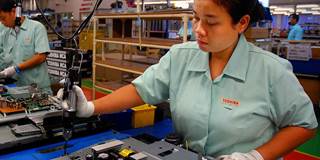As American and Chinese leaders meet for their annual Strategic Dialogue, they need not look far to find a shared challenge. Both are now victims of the “productivity paradox”: huge investments in information technology and Internet-enabled goods and services have been accompanied by slower growth in output per worker.
NEW HAVEN – In the late 1980s, there was intense debate about the so-called productivity paradox – when massive investments in information technology (IT) were not delivering measureable productivity improvements. That paradox is now back, posing a problem for both the United States and China – one that may well come up in their annual Strategic and Economic Dialogue.
Back in 1987, Nobel laureate Robert Solow famously quipped, “You can see the computer age everywhere except in the productivity statistics.” The productivity paradox seemed to be resolved in the 1990s, when America experienced a spectacular productivity renaissance. Average annual productivity growth in the country’s nonfarm business sector accelerated to 2.5% from 1991 to 2007, from the 1.5% trend in the preceding 15 years. The benefits of the Internet Age had finally materialized. Concern about the paradox all but vanished.
But the celebration appears to have been premature. Despite another technological revolution, productivity growth is slumping again. And this time the downturn is global in scope, affecting the world’s two largest economies, the US and China, most of all.

NEW HAVEN – In the late 1980s, there was intense debate about the so-called productivity paradox – when massive investments in information technology (IT) were not delivering measureable productivity improvements. That paradox is now back, posing a problem for both the United States and China – one that may well come up in their annual Strategic and Economic Dialogue.
Back in 1987, Nobel laureate Robert Solow famously quipped, “You can see the computer age everywhere except in the productivity statistics.” The productivity paradox seemed to be resolved in the 1990s, when America experienced a spectacular productivity renaissance. Average annual productivity growth in the country’s nonfarm business sector accelerated to 2.5% from 1991 to 2007, from the 1.5% trend in the preceding 15 years. The benefits of the Internet Age had finally materialized. Concern about the paradox all but vanished.
But the celebration appears to have been premature. Despite another technological revolution, productivity growth is slumping again. And this time the downturn is global in scope, affecting the world’s two largest economies, the US and China, most of all.